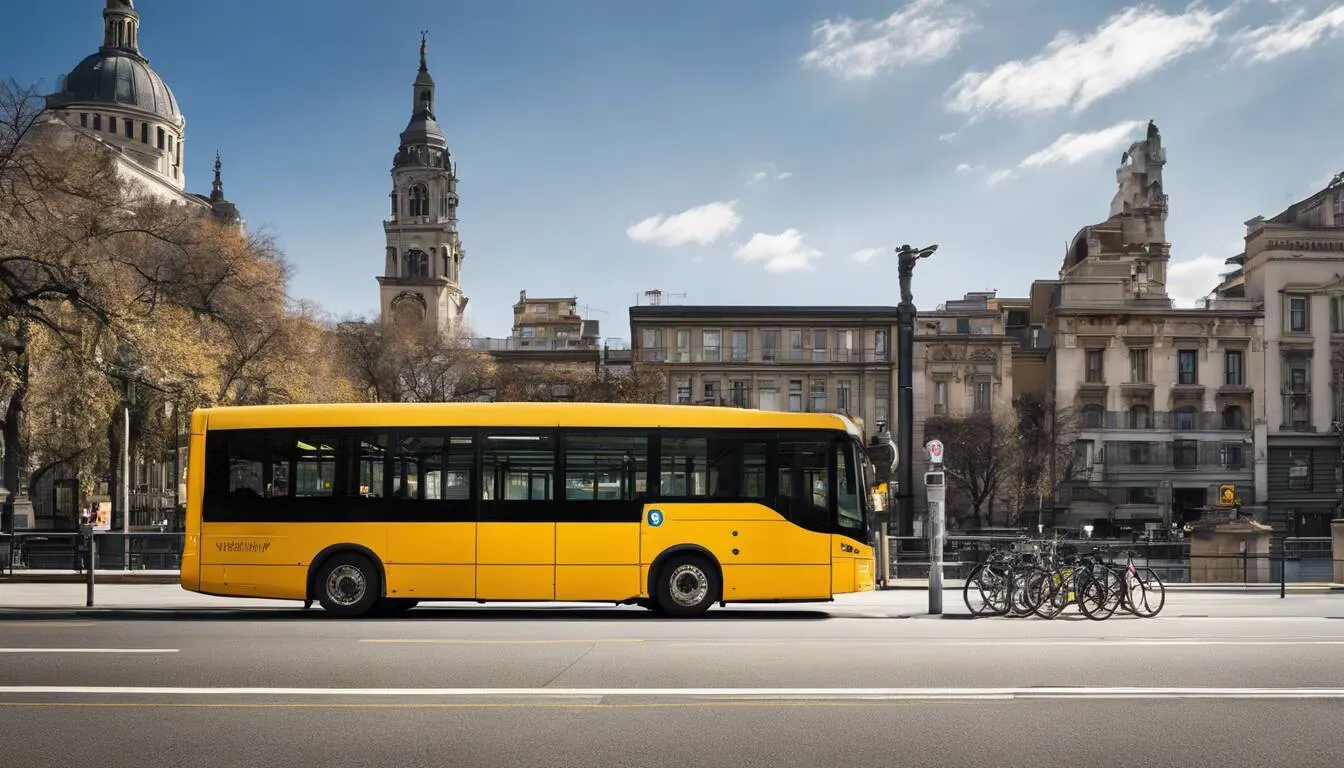Ever dreamt of weaving through serene countryside lanes on your trusty two-wheeler, but don’t want the hassle of getting there? Discover the convenience of taking your bike on a bus. But wait, there are regulations and restrictions to consider! Turn gasps of unexpected surprise into sighs of sweet relief as we unravel the must-know rules for smoothly hitching a ride with your bicycle. Saddle up as we embark on this uncharted route of fusing bus travel with biking exploration. The road ahead promises an informative and adventurous journey!
Yes, you can typically bring a bike on a bus, but it depends on the specific bus company and their policies. Many bus companies have bike racks installed on the front of the bus where you can securely stow your bike during your journey. It’s always best to check with the bus company or refer to their website for any specific rules or restrictions regarding bringing bikes on board.

Carrying Your Bike on Public Buses: Do’s and Don’ts
If you’re an eco-conscious individual who prefers using public transportation, you may want to take your bike with you. Fortunately, many cities offer public buses equipped with bike racks, allowing you to bring your ride along. However, it’s essential to abide by specific rules and regulations for a smooth journey.
DO verify if the bus model has facilities for carrying bikes before getting on board. DON’T exceed the weight limit or prohibited length and width dimensions while attaching your bike to the rack.
To help you out, here’s a list of do’s and don’ts that will ensure your journey is a safe one:
- DO check with the transit agency beforehand if they allow passengers to carry their bikes aboard.
- DON’T forget to use proper storage equipment like straps or bungee cords to keep the bike secure during travel.
- DO remove all personal belongings from the bike before storing it on the rack.
- DON’T try attaching bikes other than those equipped with compatible frames.
Now let’s see which specific bus models are outfitted with bike racks.
Specific Bus Models with Biking Facilities
Not all buses have bike racks. Before arriving at the bus stop, check online resources or get information from local transportation authorities to verify which models are outfitted explicitly with options for carrying bikes.
Here are some examples of specific bus models that allow for accommodating bicycles:
- New Flyer Xcelsior CHARGE™ electric bus;
- Proterra Catalyst® zero-emissions bus;
- Gillig Low Floor Hybrid electric bus;
- NABI 42 Compressed Natural Gas (CNG) heavy-duty transit coach; and
- Orion Articulated hybrid-electric low-floor/low-entry Transit Bus
It’s important always not to assume every public bus model accommodates bikes even if they’re from the same transit agency.
Okay, so now that we know which bus models facilitate bike carrying, let’s now focus on ensuring your bike is safe during the ride.
- According to the American Public Transportation Association, roughly 7% of public buses in the U.S have bike racks as of 2024.
- A survey in 2021 found that about 55% of bus riders reported an increase in their use of bicycles to get to and from bus stops.
- An observational study conducted in 2020 revealed that usage of bike-and-bus travel combination increased by 25% when bike racks were introduced on buses.
Ensuring Bike Safety During the Bus Ride
Bringing a bike onto public transit comes with its own set of challenges. Once you’ve loaded your bike onto the bus, it’s essential to ensure its safety during the journey. All EMBARK buses come equipped with a bike rack mounted on the front that can hold two or three bikes depending on the model. However, bikes are not allowed inside buses unless they can collapse to the size of standard luggage.
| Bus Service | Bicycle Storage |
|---|---|
| EMBARK | front of bus |
| RAPID | front of bus |
| OKC Streetcar | Two hooks inside |
Bus Routes with Bike Holding Facilities
Thankfully, many public transportation options in Oklahoma City allow users to bring their bikes along for their commute. If you’re using the OKC Streetcar system, every streetcar has level boarding and two bike hooks where you can store your bike during your journey.
When traveling by EMBARK or RAPID buses routes with bike holding facilities like those listed in the table above, loading your bike is easy – Wait for the bus to stop completely, then secure your bike on the rack by squeezing the handle and place it over your front wheel. Ensure all loose items have been removed from your bike before paying your fare. Upon arriving at your destination, exit through the front door and let the driver know you’ll be removing your bike from its position.
If riding an E-bike on either EMBARK or RAPID buses, there are specific restrictions that must be adhered to: no homemade e-bikes will be accepted; only sealed batteries of serviceable condition are permitted; lead batteries cannot be brought aboard any vehicle, while correctly-designed bikes that fit within standard accommodations may require a top-up charge upon arrival.
Understanding these rules is vital as failure to comply with these requirements may lead to your bike being denied access onto the vehicle.
See Related: Can You Bring a Bike on a Peter Pan Bus? Here’s What You Need to Know
Bike-Free Public Transit Alternatives
While biking to get around your city or town is an excellent way to stay active and environmentally conscious, it might not be possible in all circumstances. Fortunately, many public transit options cater to people who either don’t own a bike or can’t bring their bikes with them for whatever reason. Some cities have introduced bike-free transportation alternatives, such as electric scooters, skateboards and hoverboards, zip cars, and car-sharing services.
For example, popular ride-hailing apps like Uber and Lyft allow you to request rides in cars equipped with bike racks. Transit systems also offer bike-free alternatives like buses and trains which provide ample space to sit or stand without having to carry your bike with you.
Ultimately, the choice between bringing your bike onto public transit or relying on bike-free transportation options depends on your specific needs.
See Related: Can You Bring Your Bike On The Bus To NYC? A Guide To Taking Public Transit.
Paying for Bike Transportation versus Bike-Free Transit
Concerning the cost of using public transit, there might be a discrepancy between fees charged for general passenger travel versus those that include transportation of personal bikes. In some states and cities, such as New York City and Chicago, it’s free to bring your bike aboard select trains or buses during certain hours.
However, other cities charge additional fees for transporting a bike on their public transport services. For example, San Francisco charges $3 per trip for every passenger who brings their non-folding bicycle aboard its transit system.
Think about it like paying extra baggage fees at the airport – it’s a necessary expense if you want to take your stuff with you on the plane.
Another option is choosing bike-free transit alternatives instead of lugging bikes around. However, these alternatives come with their own fees; ride-sharing apps charge riders according to distance traveled and time spent commuting.
After weighing various financial options while considering how to transport your bike on public transit or where you need to go, it’s vital to take into account the needs and rights of fellow passengers while using public transport.
- The takeaway is that when using public transit, there may be differences in fees for general passenger travel compared to transporting a personal bike. In some cities, like New York City and Chicago, it is free to bring your bike on select trains or buses during certain hours. However, other cities, such as San Francisco, charge additional fees for bringing a non-folding bicycle aboard their transit system. Choosing between bringing a bike or opting for bike-free transit alternatives depends on individual preferences and financial considerations. It is important to consider the needs and rights of fellow passengers while using public transport.
Inter-City Carriers and Bikes: What You Should Know
Many inter-city carriers also allow bikes on board, but just like with intra-city buses, this allowance depends on the rules and restrictions of the specific carrier. Buses that travel longer distances typically have more space available for bicycles – usually at the back of the bus – when compared to intra-city buses. In some cases, the company may require you to follow specific regulations or opt for “bulky baggage” if their cycling spaces are fully occupied.
It’s important to note that not all inter-city carriers allow bikes on board, while others might enforce strict regulations regarding bike transport. Before booking your ticket, it’s essential to read through the carrier’s rules and regulations regarding bike transport to avoid any surprises or disappointments on departure day.
When riding long distances in Europe, FlixBus is a top choice for travelers looking to take their bicycle along. The service provides bike carriers at the back of buses or special covers in the baggage compartment that keep your beloved ride intact until your destination.
Imagine taking a bike tour through Amsterdam or leisurely cycling through Munich; an affordable and convenient way would be using FlixBus as it caters to cyclists and non-cyclists alike.
Remember that there might be additional charges for transporting bikes as bulky baggage versus traveling with them mounted onboard. However, this option could provide more peace of mind since bulky baggage is given special care during loading and unloading.
When traveling between different cities and carrying your bike around happens to be part of your plans, research in advance what options are available so you can make arrangements ahead of time. By understanding all the different aspects involved in moving with a bicycle using inter-city carriers, you will have a more relaxed trip allowing you more time focusing on exploring your destination.
